Digital Thinkers Conference San Francisco Palace of the Fine Arts

Conference Review: Enterprise UX 2017, Part 1
March twenty, 2018
The 3rd annual Enterprise UX (EUX) conference opened on Wednesday, June vii, 2017, when a mean solar day of workshops convened at the Argonaut Hotel, which is located in the San Francisco Maritime National Historical Park at Fisherman'due south Wharf. The primary conference took identify Thursday, June viii, through Friday, June ix, at the Innovation Hangar in the Palace of Fine Arts in San Francisco's Marina Commune.
Overall, Rosenfeld Media, the producer of this event, delivered a well thought out conference feel, with first-class content. I'thou glad the organizers made attending EUX easy for me this year past moving the conference from San Antonio to San Francisco, which is a bully city to visit. In recent years, 1 of my pattern goals has been the consumerization of enterprise software, and then information technology was high time I attended this conference. At present that I accept, I'one thousand deplorable I missed the first two.
The EUX Web site poses the question: "Why Enterprise UX?" Here'south Rosenfeld Media's answer:
"Enterprises—huge, distributed, complex businesses, authorities agencies, and other large organizations—account for an enormous portion of the global economy. Yet people who engage with enterprises—employees, customers, and managers—face experiences that are irksome, fragmented, complicated, and just plain awful, especially when compared with consumer-facing experiences. Information technology'southward time to right these wrongs."
In Part one, I'll review the conference feel, as follows:
- Arrangement
- Content and Presenters
- Proceedings
- Venue
- Hospitality and Events
- Community
- Tutorials
Later in this first function of our EUX 2017 review, Jim Nieters and I will embrace each of the workshops we attended on Wednesday, June vii. And so, in Parts ii and 3, we'll review the conference sessions.
Organization
Equally for the 2015 and 2016 EUX conferences, Uday Gajendar, Design Lead at PayPal, and Dave Malouf, then Director of Product Design at DigitalOcean, served with Rosenfeld Media'southward Lou Rosenfeld on the Plan Commission. This year, Lada Gorlenko, Director of UX Inquiry at Smartsheet, joined the programming endeavor. The outcome was a perfect residuum of male and female speakers, which was a pregnant comeback over the first two EUX conferences. EUX 2017 was a well-planned, well-organized event. Figure 1 shows the Program Committee onstage, as well as headshots of Lada, Lou, Dave, and Uday, from left to right. They shared hosting duties during the conference.
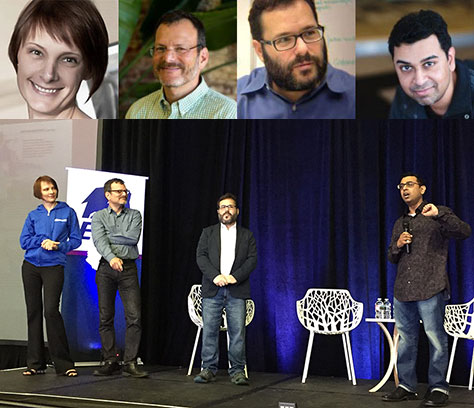
This unmarried-track conference was organized into four themes:
- Crafting Enterprise Experiences—"The enterprise setting forces us to redefine what good design means. We'll explore how unique factors like complication, scale, and lack of command tin touch our craft and completely change our expectations."
- Leading Teams That Execute—"Blueprint leaders need to exercise more than than hire, railroad train, and mentor great craftspeople. They must get people to work together every bit an interdisciplinary team, bound by a shared vision of what a successful enterprise experience can be. We'll explore how successful enterprise UX teams work to create, own, and execute their visions."
- Transcending Silos—"Our work impacts other partners within our organizations, and our success depends on them as much as [their success depends on us]. To operationalize [User Feel] throughout the enterprise, you'll need to have tough conversations with stakeholders in [Human Resources (60 minutes), Information technology (It)], and other critical areas. Nosotros'll explore ways to collaborate across silos, set up expectations, establish shared goals, and raise the value of design throughout the enterprise."
- Creating a Legacy—"What factors ensure the growth and sustainability of enterprise [User Experience]—or indicate trouble ahead? How tin we inoculate ourselves against factors that kill enterprise UX teams and practices? How do nosotros craft a multidecade vision for ourselves and our organisation that inspires followership and undying respect? We'll learn from leaders who've been around long enough to tell bully stories and teach valuable lessons of what makes or breaks an enterprise's UX capabilities over the long booty."
This was a well-paced conference, with half-60 minutes morning and afternoon breaks each day. Everyone shared the same conference experience, which fostered good discussions during those breaks.
Content and Presenters
The conference kicked off and closed with an hour-long keynote accost—from Elizabeth Churchill, Director of User Experience at Google, and Mark Templeton, formerly President and CEO at Citrix Systems, respectively.
Each morning and afternoon of the two-day conference covered a unlike theme, each of which had a theme leader who wrapped things up with a discussion, equally follows:
- Crafting Enterprise Experiences—The theme leader was Theresa Neil, possessor of Strategy + Pattern.
- Leading Teams That Execute—Phillip Hunter, Caput of UX for Amazon Alexa Skills, was the leader for this theme.
- Transcending Silos—The leader for this theme was Toby Haug, Head of Design & the Co-Innovation Eye, EMEA, at SAP.
- Creating a Legacy—The theme leader was Colette Vardeman, Executive Director of Design at USAA.
The Program Commission tailored the content to an audience comprising "people who care well-nigh delivering great enterprise experiences—whether they work within an enterprise or for an enterprise software vendor." They broadly defined this audition to encompass UX professionals—including designers, researchers, and team leaders—product managers, developers, marketers, and other "decision makers whose organizations stand up to benefit when their employees and customers relish better experiences."
Proceedings
The organizers provided the conference's complete schedule in a combination badge / program booklet. The bluecoat information was duplicated on both covers, so always oriented for easy reading past others, while the plan information was printed upside down relative to the badge. So the wearer didn't have to flip the booklet over, but could just pick information technology upwards to read information technology. Plus, in the "Program" and "Speakers" sections of the EUX 2017 Spider web site, Rosenfeld Media provided detailed information about the conference, including special events.
Rosenfeld Media is preserving admittedly complete historical information for EUX 2015, 2016, and 2017 on its Web site. After each event, they've added links to slide decks on SlideShare, videos on YouTube, and sketch notes for many sessions on the conference's "Plan" page. This is a generous offering for attendees who want to refresh their memory about certain sessions—even more than so for people weren't able to attend EUX.
Throughout the conference, sketchnoter MJ Broadbent captured the essence of the presentations in her fabulous sketchnotes, equally shown in Figure 2.
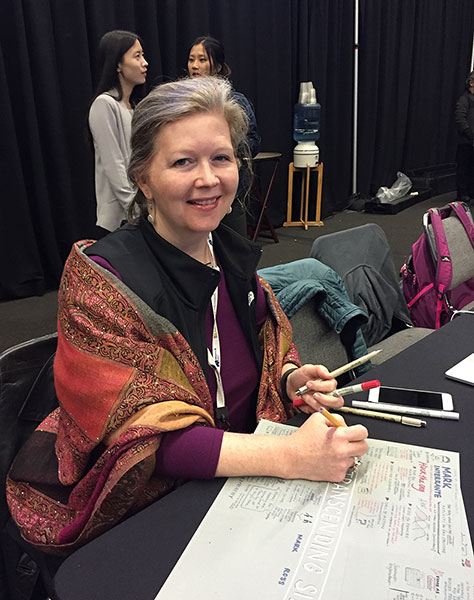
Venues
The Argonaut Hotel—a nautical-themed boutique hotel—is located in a converted warehouse edifice that was originally built in the early 1900s and was both the briefing hotel and the venue for the briefing workshops and is shown in Figure 3. Some of the rooms housing the workshops were more commodious than others, but they were all repose, well-lit, aesthetically pleasing spaces that were conducive to learning. The Argonaut earned the stars I allotted to the venues in my rating, even though it was not the main venue. The Blue Mermaid Restaurant, hotel bar, patio, and other public spaces in this comfy, well-designed hotel provided an environment that encouraged socializing with other conference-goers.
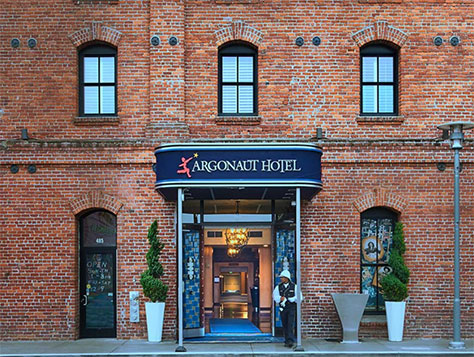
Image source: Argonaut Hotel
The main conference took place within the concrete expanse of the Innovation Hangar, shown in Figure 4, within the cute setting of the Palace of Fine Arts, shown in Figure 5, which is in San Francisco's Marina Commune and was originally constructed in 1915 for the Panama-Pacific Exposition. The cold, drafty interior surroundings of the Innovation Hangar stood in stark contrast to the lovely landscape of the Palace of Fine Arts, with its colonnades and central rotunda partially surrounding a minor bogus lagoon that attracts swans, shown in Figure six, ducks, geese, and other waterfowl, as well every bit street musicians and tourists. I enjoyed hanging out around the lagoon.
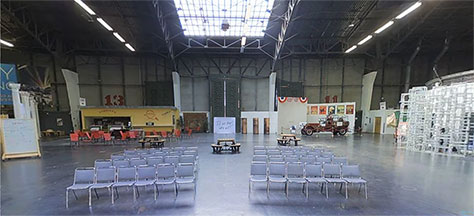
Image source: Innovation Hangar

Image source: Photograph by Kevin Cole (CC BY 2.0), from Wikimedia Commons

But inside the principal archway of the Innovation Hangar, a massive open area housed the registration desk and the booths of the conference'southward sponsors, too as an area for dining and discussions, shown in Figure seven, where refreshments were served throughout the day. The open up layout of this space ensured good traffic flows throughout the venue.
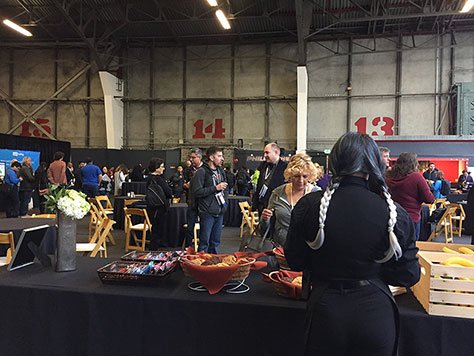
Unfortunately, only two days before the briefing began, the Innovation Hangar announced its impending endmost, citing "the fiscal strain of leasing infinite." The house sound/video systems clearly were not well maintained during this menses and acquired issues throughout much of the first twenty-four hour period of the conference. The venue's staff struggled to remedy these problems.
In addition to the audio/video bug, the other big deficiency of this venue was its lack of comfort. Even so, the big, curtained-off space within which the conference sessions were presented did ensure that anybody had seat with a clear view of the stage and the ii large screens on either side of it.
I commuted into San Francisco daily for the conference, merely I've stayed at the Argonaut Hotel before. The rooms are spacious and very comfortable, making this an fantabulous choice for the conference hotel.
Hospitality and Events
On Wednesday, June 7, our 24-hour interval at the Argonaut Hotel began with an early breakfast before the workshops started. A delicious lunch was served on the patio shown in Figure eight. During the main conference on Thursday and Friday, June 8–June 9, at the Innovation Hangar, each solar day attendees enjoyed a continental breakfast, refreshments at forenoon and afternoon breaks, as shown in Figure 7, and a buffet lunch.
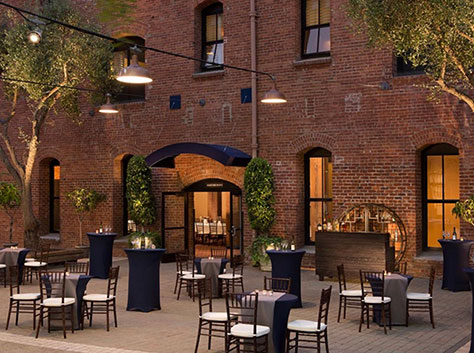
Epitome source: Argonaut Hotel
Rosenfeld Media did a corking chore of sustaining the conference'southward social milieu throughout both day and nighttime and offered a variety of events to keep attendees entertained during the conference, as follows:
- Wednesday, June 7:
- San Francisco Architecture Walking Tour with Jorge Arango—Information architect, Information Architecture: For the Web and Beyond coauthor, and Futuredraft partner Jorge Arango served as the guide for this afternoon bout of downtown San Francisco's architecture. During the tour, he looked at the urban center as an information surround and considered how people form mental models of urban environments. I was very sorry to observe that this tour was scheduled against the workshop I'd committed to attention. Next time, I hope Jorge does the tour again, but later in the day, at a time when in that location are no conflicts.
- Happy Hr at the Dorian—At the cease of the day, EUX served complimentary cocktails and appetizers at this restaurant on trendy Chestnut Street.
- EUX17 Speaker-Sponsor Reception—Later in the evening, UXmatters attended a reception for the speakers and sponsors at the San Francisco Maritime National Historical Park'southward Visitors Center on the ground floor of the Argonaut Hotel, where some of the park's exhibits are on brandish, as shown in Figure ix, including the magnificent Fresnel lighthouse lens, shown in Figure 10. Hors d'oeuvres and drinks were served.
- Th, June 8:
- Opening Reception—Immediately post-obit the Enterprise Storytelling Sessions at the end of Mean solar day one of the conference, this reception took place in the open surface area of the Innovation Hangar amidst the sponsors' booths. Refreshments were served.
- Fri, June 9:
- Round-table Discussions—At lunch, attendees with common interests gathered for round-table discussions.
- Book Signing—During the lunch pause, Lou Rosenfeld and Jorge Arango signed copies of their book Information Compages: For the Web and Across for attendees, as shown in Figure eleven.
- Closing Party at Autodesk Gallery—Afterward Day 2 of the conference had ended, briefing attendees segued to the beautiful Autodesk Gallery for the best briefing party I've ever attended. The gallery, shown in Figure 12, features the artistic works of Autodesk'southward diverse customers, and at that place were many fascinating exhibits to explore. The conference organizers had also invited many leading lights of the local UX community to attend the party. Information technology was great reconnecting with everyone. The oversupply enjoyed fabulous food and drinks.
- Karaoke—For those who weren't ready for their EUX 2017 experience to end or just hadn't still had enough partying, vans transported us to the Encore Karaoke Lounge on Nob Colina. We sang, danced, and mixed with local karaoke singers till the wee hours of the forenoon.
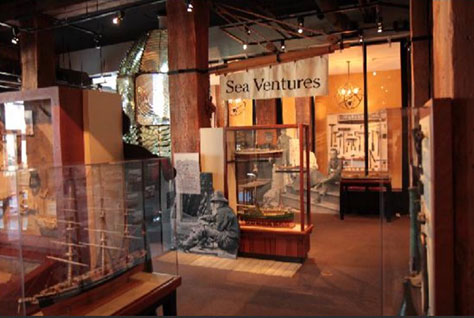
Image source: TripAdvisor
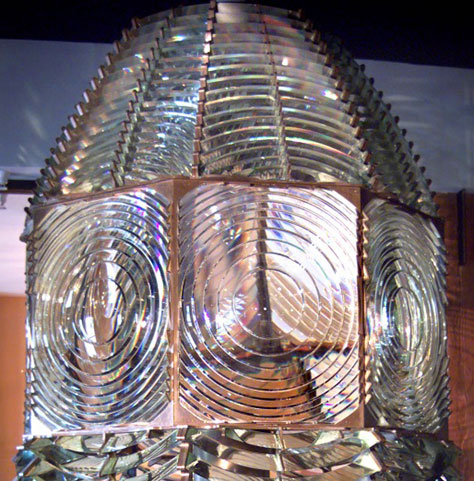
Image source: NPS.gov
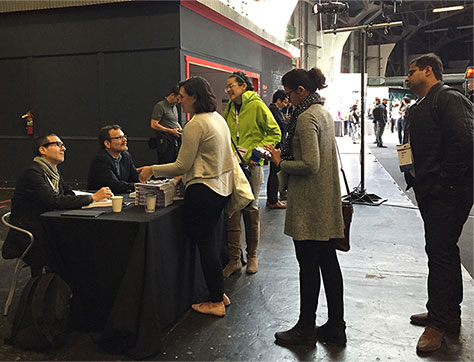
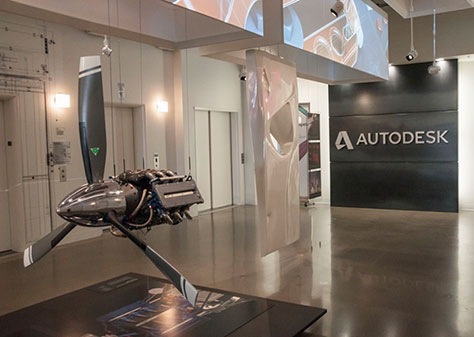
Image source: Cleantech Group
Community
The sense of community at this conference is reminiscent of that at the IA Summit, of which Lou Rosenfeld was 1 of the organizers in its early years. That is to say, the organizers did a great job of fostering community. Of course, the conference's focus on enterprise user experience brought together a community with a mutual cause. Plus, the well idea out social events each evening ensured that no one had to spend that time on their own.
Almost all of the speakers were UX professionals—many of them in leadership roles or working equally consultants.
Workshops at the Argonaut Hotel
Four full-day workshops took place at the Argonaut Hotel on Wednesday, June 7, from 8:30am–4:30pm, as follows:
- "Scalable Pattern Systems"—Nathan Curtis, Founder at EightShapes
- "Production Management for UX People"—Laura Klein, Principal at UsersKnow, and Kate Rutter, Principal at Intelleto
- "Design Your Design System"—Peter Merholz, VP of Blueprint at Snagajob, and Kristin Skinner, Managing Managing director at Adaptive Path
- "Strategy for Design Leadership"—Dave Malouf, Director of Product Design at Digital Ocean
I had recently attended Peter Merholz and Kristin Skinner's tutorial "Org Design for Design Orgs" at O'Reilly Blueprint Conference 2017, so I chose to review Laura Klein and Kate Rutter'south workshop, "Product Direction for UX People," while Jim Nieters decided to review Dave Malouf's workshop "Strategy for Pattern Leadership."
Product Management for UX People
Reviewer: Pabini Gabriel-Petit
Presenters: Laura Klein and Kate Rutter
The goal of this workshop was "to help [us] explore ways to ameliorate the products [nosotros] build by knowing how Product Direction and User Experience connect." The calendar for the day covered the following topics:
- Who does what?
- Know your business organization.
- Know your customers.
- Measure success.
- Find features.
Who Does What—and What Do You Practise?
This part of the workshop covered the roles of UX designers and production managers. The presentation included several graphs of height tasks from research results that Laura Klein has published on the Rosenfeld Media site, "Product Teams: Who Does What?" In the graph "Top Designer Tasks," I found the emphasis on visual-design tasks of one kind and another—four of five tasks—rather disturbing inside the context of UX blueprint. This made me wonder whether people who I wouldn't consider to exist UX designers were being called UX designers. Only 69% of respondents included interaction design among their top tasks. In my stance, if interaction design—which is a foundational skill for a UX designer—isn't one of a designer'south height tasks that designer is not a UX designer. The other skill I consider to be a core skill is user-centered design, which wasn't fifty-fifty mentioned among the outlier tasks. We demand to ascertain UX blueprint more explicitly.
A graph of peak Product Management tasks included roadmaps, product planning, feature prioritization, feature signoff, and excess management. As Figure xiii shows, there is a lof of overlap between Product Management and UX pattern tasks. According to Laura's research, "Nobody knows what to expect from u.s.. Nobody reallyknows who does user research." Kate asked the states to spend five minutes because all the things we do, placing them on a four-square chart that mapped their importance and how much fourth dimension we spend on them, then two minutes discussing our chart with our neighbor.
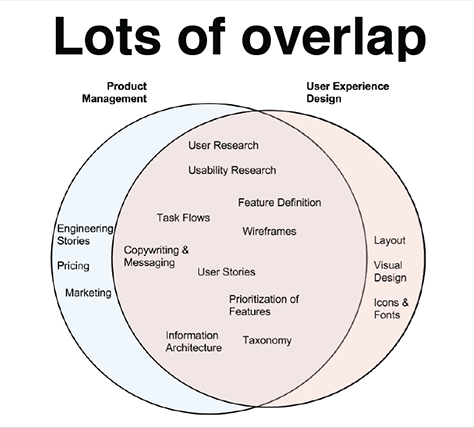
Know Your Business organization
Kate shared the product stack in Effigy xiv, showing the nexus of a visitor'southward purpose within it. "Knowing your business means knowing how non to get out of business. Budgeting predicts where a company is going in the time to come—its priorities," said Kate.
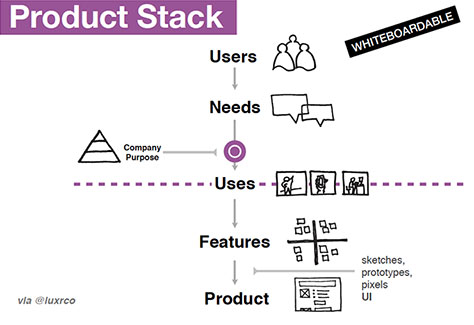
"Accumulate answers and validate them as bear witness emerges. What yous know should be based on evidence," advised Kate. "Something weird is happening in the Production Management world. They're giving upwardly roadmapping. That's scary."
We were asked to "selection an idea to use for the mean solar day—a new feature for a production you are working on or an Amazon feature," then spend five minutes creating a product snapshot like that shown in Figure fifteen, answering these questions:
- "Who are the people, or users, who have a trouble and would use our solution?<"/li>
- "What problems do they have?"
- "What is a proposed solution that would address their problem?"
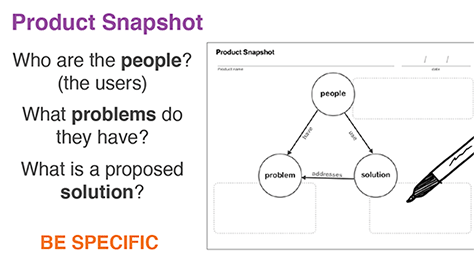
Nosotros over again paired up with a neighbor to discuss our product snapshot, then participated in a broader discussion—a pattern that persisted throughout the day for most exercises. In the next 5-minute practice, we answered the question "How does your business make money?" past listing the ways our visitor makes money in a Business organization Model column, then list the kinds of people who pay for our production.
Know Your Customers
"Users are the thing we should all understand," Laura stated. Then, she introduced the user map shown in Figure 16. A user map should be highly specific to a particular type of user. Capture facts most these users and their bug, behaviors, needs, and goals. Wait at the by and future. When filling in the user map, answer the questions shown in Figure 17.
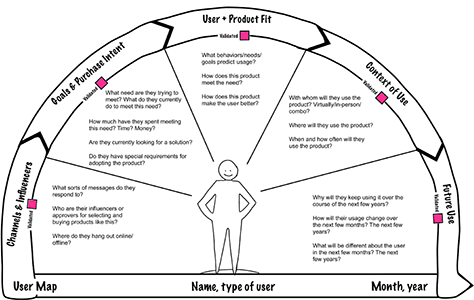
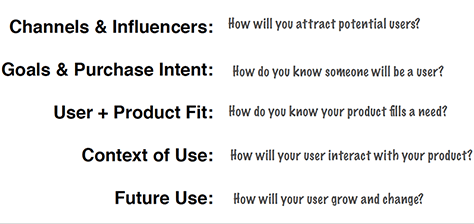
In subsequent, 2-minute exercises, when considering dissimilar parts of the user map, we asked the following questions:
- Channels & Influencers:
- "Where does your user acquire most products similar this?"
- "What sorts of messages practice they respond to?"
- "Who are their influencers or approvers for selecting and buying products like this?"
- Goals & Purchase Intent:
- "What need are they trying to see?"
- "What do they currently do to meet this need?"
- "How much fourth dimension exercise they spend meeting this demand?"
- "How much money accept they spent meeting this need?"
- "Are they currently looking for a solution to meet this need?"
- "Practise they take whatsoever special requirements or needs for adopting this product?"
- User + Production Fit:
- "What behaviors/needs/goals predict usage?"
- "How does this product meet the need?"
- "How does this product brand the user better?"
- Context of Utilize:
- "With whom will they use the product? Nigh/in-person/combo?"
- "Where will they utilise the production?"
- "When and how often will they utilise the product?"
- Future Use:
- "Why will they keep using it over the form of the side by side few years?"
- "How will their usage modify over the next few months? The adjacent few years?"
- "What will be unlike about the user in the next few months? The side by side few years?"
"Agreement the controlling [and] buying process can help with messaging, positioning, and fifty-fifty user inquiry!" said Laura. "Understanding user intent can assist you know how much convincing and onboarding volition be required in early user interactions. Understanding needs will help you predict which features are most important for specific users. Understanding how people use your product helps you determine the platform and pattern requirements. Information technology can as well aid y'all protect your [users] by keeping their data prophylactic. Understanding hereafter usage helps you lot meliorate user retention by giving users an incentive to proceed using your product after the kickoff few weeks.
"Needs finding is the matter nigh neglected past product teams," observed Laura.
Subsequently a listening activity, in which we carve up into pairs and each interviewed the other for 5 minutes about the procedure of buying effects for the home, Laura shared some guidelines for interviewing users:
- "Ask open-ended questions." Kate added, "If you're request open-ended questions, you're talking maybe ten pct of the time. Try to talk less. Ask more than questions. Ask follow-up questions."
- "Let the participant lead."
- "Give the participant something to accomplish to."
- "Recruit and screen participants to make sure you're talking to people who will be helpful with the blazon of research yous're doing."
- "Understand why your participant does what she does or feels the mode she does."
- "Shut up."
So, nosotros tried interviewing one another once again—this time near the online job-search procedure.
Mensurate Success
"Metrics are merely user behavior described with numbers," Kate told the states. She discussed various user-inquiry approaches that "help u.s. know our product is working for our users," as shown in Figure eighteen. "Qualitative inquiry is the best source of metrics."
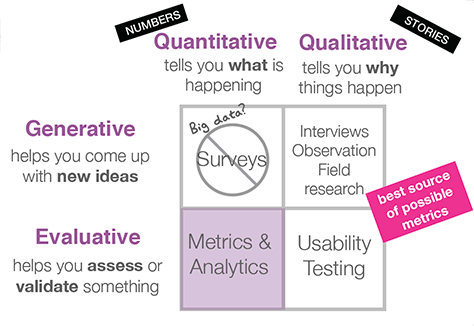
Metrics and analytics approaches include the post-obit:
- "click tracking
- "analytics packages
- "A/B testing
- "KPIs / OKRs
- "usage statistics
- "conversions"
Figure 19 shows some common metrics; Figure xx, some metrics frameworks—Pirate metrics and Google'southward Eye metrics.
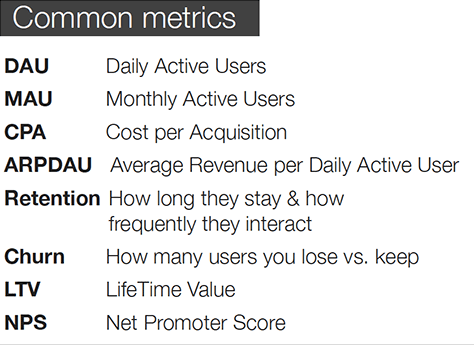
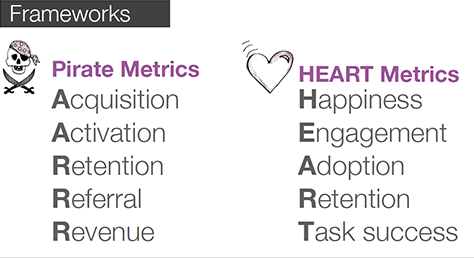
"A good metric measures the usage of your product by a person," and it is
- clear and specific:
- "Know what interactions stand for the desired user behaviors."
- "Identify the specific interactions that support the action or beliefs."
- "Find the numbers to runway these interactions.
- normalized—rate or ratio:
- "Percentages are inherently comparative."
- "They balance out big changes in full quantities."
- comparable—time stamped:
- "Captured at regular intervals."
- "Directly comparable over a bridge of time."
- actionable—non vanity:
- "total number of users
- "downloads
- "page views
- "likes
- "funding press releases
- "manufactures in media"
- changes your behavior:
- "Don't just ask questions. Know how the answers to the questions volition change your behavior."—Alistair Croll, from Lean Analytics
"Lean analytics are the best metrics around products," said Kate. "Numbers for vanity metrics but ever get up. They won't change your behavior." Laura brash, "Metrics should be about things users want to do. Metrics reflect user behavior," as demonstrated in Figure 21. "They are predictive of meliorate behavior," remarked Kate. Laura explained that "leading metrics indicate future apply. All metrics are inherently gameable."
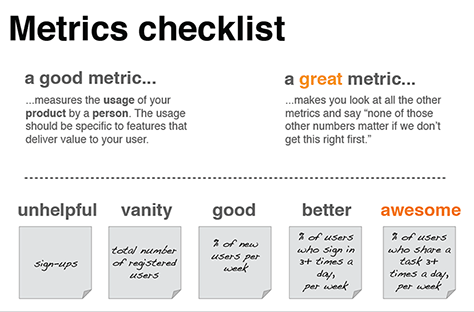
Our next do involved brainstorming ideas for metrics for three minutes, and then focusing on i metric for five minutes to make information technology awesome—ensuring that the metric begins with a number and has a time basis and an object basis. "What could you count to make sure your feature
is working for your customers?"
Detect Features
"Getting the right features and the features right." Laura led a give-and-take about how we currently cull features. She said, "The characteristic isn't the goal. The goal is the alter in metrics that volition come from a change in user behavior. The characteristic is merely the trigger for the beliefs change. When you know the goal, you can remember up a lot of possibly better featuers that could work." In a ten-minute exercise, nosotros assessed the last feature our squad built—why we built it, what metrics we were hoping to move, and how we measured them.
In the final, ten-minute exercise, we chose a adequately big feature and considered its complexity. "How long will the feature take? What else practise nosotros have to build for this feature to work? Where is the complexity hidden? What does every piece of it imply?"
"When nosotros understand the complication of what we're building, we make meliorate decisions," acknowledged Laura. "Expert product managers say no all the time."
Wrapping Up
"Users are metrics," ended Laura. This workshop covered a lot of ground in a off-white amount of depth. I found the segment on metrics almost edifying.
Strategy for Design Leadership: Climbing Strategy Mountain
Reviewer: Jim Nieters
Presenter: Dave Malouf
For his workshop, Dave used the metaphor of climbing strategy mount, characterizing the post-obit agenda equally "The Programme for the Climb":
- Preparing for the Climb
- Surveying the Mountain
- Visualizing the Acme—depicted in the hero image at the showtime of this review
- Determining the Best Path
- Points: Observe, Measure, Learn, Arrange
Equally a metaphor, the concept of climbing strategy mount worked likewise equally any other, in the sense that it helped participants visualize his core lessons. For example, to achieve any objective, you must know where you are and know where you are going—part of "Preparing for the Climb." If someone chooses to follow Dave's model, they can envision the purpose, value, and high-level procedure for each of these stages.
My overall impression of the workshop was that Dave has clearly internalizing how the corporate world operates. He has a firm grasp of how to stand up back and decide how to all-time brand an impact in his organization.
Preparing for the Climb
In the section "Preparing for the Climb," Dave asked the core question: "What is Strategy?" He presented some examples of tactical versus strategic goals to highlight the differences. A tactical goal might be: "I volition complete X by Y date." The strategic corollary might be: "By completing X, Y, and Z, we will see a change in these key results that will tell us nosotros are trending toward A, B, C." While I hold with his signal that, if we desire to influence executives, we need to understand how to navigate the terrain of strategy, Dave'south examples of strategic goals could have been a bit more tangible and more relevant to UX blueprint strategists.
Dave quite accurately pointed out that getting to strategy is non piece of cake. Getting in that location takes an understanding of the following elements:
- current land—knowing where you are
- desired state—knowing where you are going
- purpose and values—having a reason to brand the climb
- the plan—a map from where you are to where you lot're going
- measures of progress—landmarks to look for
Surveying the Mountain
In this section, Dave asked the question "What does your mount look similar?" He suggested that it's all about perspective. Where are you in relation to the target? Are you far away? Are yous nearly the goal? When you look at a mountain such as Mount Rainier from a long view, the mount towers over everything, but from far away, shut to your context—for example, downtown Seattle—Mount Rainier looks relatively smaller. But when you're on the mountain and in the moment, yous tin can lose track of the top itself for any is in immediate proximity—the tasks you're completing. So, when considering strategic objectives for a UX squad, you need to realize that it'southward all about perspective. The objective can seem so daunting equally information technology appears today. Simply, if you tin stand dorsum and look at it in context, it tin announced to be an accessible goal.
Dave then talked nearly the concept of creating clear team mission and vision statements to assist align teams around what they need to do—and what the experience will exist once they've achieved their goals. Effigy 22 shows an instance of a team mission for a squad Dave worked with at HPE
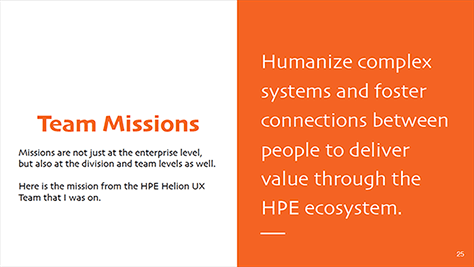
Dave pointed out that a mission statement says what a team is going to do, while a vision statement describes what it will exist like when the squad arrives. Together, these statements provide teams with a sense of purpose.
At this betoken, Dave had tables break into groups to discuss our missions for ourselves and our teams in our current roles. He asked us to consider several questions, including the following:
- What is our motivation?
- What value volition we create?
- Who benefits from this value?
- Why will they intendance?
We then shared stories—experiencing common empathy—learned from one another, and created a sense of aligned meaning within our groups. Dave provided some not bad examples of why an aligned vision matters. For case, Dave and his wife might agree to go along vacation. However, would he and his wife's perspective of a great vacation exist aligned? Without a shared vision, unlike members of a team might be running hard toward very different objectives.
At this indicate, Dave had the states pause into groups again, focusing on what information technology is like for each of the states to communicate with our team. In Part ane of this breakout, we shared stories; in Part two, we created affinity diagrams of our stories. We constitute commonalities and worked to marshal our perspectives.
Visualizing the Peak
In visualizing the superlative, the objective supports the purpose the team has defined for itself by first answering these questions:
- What was the hurting before?
- What is the solution?
- What is the value to the people you're creating something for?
- What information supports the solution?
- How volition we know when we're successful?
Dave suggested that, when we're identifying painpoints, solutions, and value, we tell emotional stories that engage executives. Sales teams present emotional arguments. Similarly, we should highlight the bodily pain customers experience. Pigment a clear picture of the experience customers volition take when they feel the new solution.
In lieu of telling a story, Dave recommended that we describe the desired end state equally both sufficient and platonic, as shown in Figure 23.
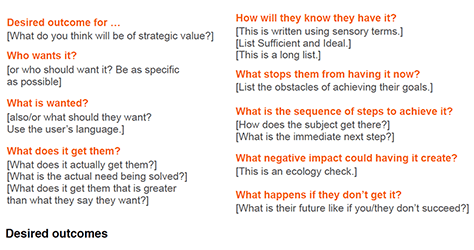
Dave and then walked us through a desired upshot do. For a specific product, we identified the following:
- What is wanted?
- What does it go them?
- How will they know they have what they desire?
When talking nearly how customers will know when they have their desired upshot, we demand to use sensory terms. That is, nosotros demand to talk almost what they see, hear, and experience. We also need to talk near what would be sufficient, or barely adequate, versus what would exist hopelessly idealistic, then identify what lies in between these extremes. The truth is that business factors such as market weather condition, competitive pressures, financial viability, and resource availability determine that line between sufficiency and the hopelessly idealistic.
Side by side, we broke out into groups for another exercise, in which we worked through the entire canvass of a desired outcomes template. Referring to affinity work nosotros did get-go as a grouping, we built out the canvas progressively, using Post-it notes. We added sensory and sequence input on different Post-it notes.
Determining the Best Path
Afterward a lunch break, we started discussing how to determine the best path to attain the goal that the team aligned around earlier. To determine the all-time path to whatever goal, a squad must decide how much detail it needs virtually the terrain it volition be crossing. This will help them determine how much fidelity their last vision must have before they commence on their journeying. When choosing the path, Dave recommended determining what issues the team must address past request the questions shown in Figure 24.
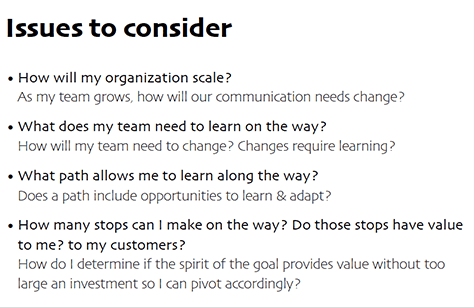
The challenge I faced at this point in the workshop was attempting to necktie the general bug Dave had presented—such every bit "deciding the all-time path" past request questions like "how my organization will scale?" Because we were running out of time, Dave threw in some tangible data points and organizational issues for u.s. to consider. I actually valued all of the points Dave made and the questions he asked— he was right on with them. Nonetheless, the challenge I had was understanding where I was—that is, agreement my context.
At this indicate, Dave walked through the process of conducting a SWOT analysis, which, as Figure 25 shows, is an analysis of
- Strengths
- Weaknesses
- Opportunities
- Threats
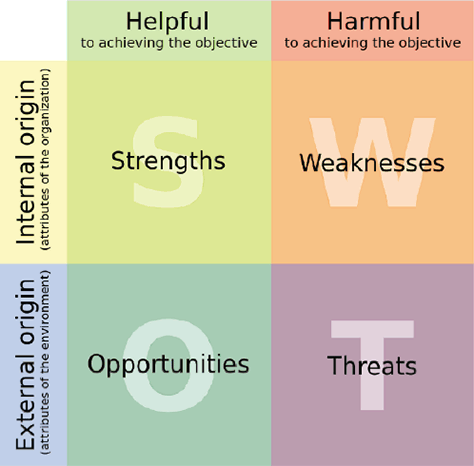
The purpose of a SWOT analysis is to evaluate each of these factors, enabling y'all to assess your ability to achieve your goal. While I agree that a SWOT analysis is a valuable tool in a strategist's arsenal, I wasn't sure why we were talking about it in this context, except that information technology's a useful tool for strategists.
Finally, we learned almost culture maps, which help teams empathise their organisation's readiness for change or growth. (Figure 26 shows an example.) They also help teams to design new incentives and structures to increase their initiative's chance of success. Using this tool can help teams identify possible outcomes and behaviors that would support or hamper their ability to achieve their goal. It also helps them identify explicit levers—for case, how people are rewarded and punished, rules, budgets, policies, processes, and organizational structure, so teams can drive change. It also helps them identify unstated or implicit levers or unwritten rules, routines, habits, values, behavior, and politics that might be unconscious or hidden. This tool helps teams to sympathise the obstacles they might run up against and form strategies for circumventing these obstacles.
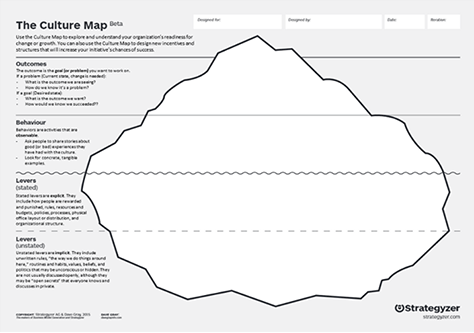
Points: Observe, Measure, Larn, Adjust
Side by side, Dave talked well-nigh what he called points—that is, the points at which teams should tin can collect data and then they tin can acquire and pivot, if necessary. If something is non working, teams should notice new tools or ways of driving change. In this context, it is critical to gather data—both qualitative and quantitative data, as outlined in Effigy 27. The information that teams choose to gather and nowadays should:
- Demonstrate value for the user.
- Nowadays plenty data to be worth measuring.
- Non be besides far out.
- Exist well enough defined.
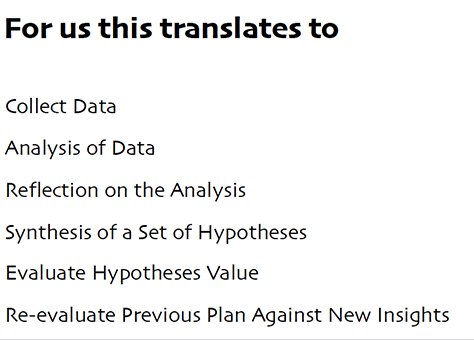
Dave introduced the acronym OODA, which stands for Observe, Orient, Determine, and Act. He suggested that all teams should have the instrumentation at their disposal to assist them understand how the team is doing against their goal—the summit.
Nearing the finish of the workshop, teams had the opportunity to build a path to their peak. Along that path, they reviewed the sequence of desired outcomes against the strategic issues Dave had described earlier. He suggested we ping-pong our plan confronting questions that set the path, but to exist honest, I could non follow what this meant. Dave did indicate out that in our plans, we should exist certain to add together answers to the questions "What are we going to learn?" and "How are we going to measure information technology?"
Dave shared some guiding principles that could provide focus, showing this example of the principles the Rackspace Experience Design team created:
- Run across me where I am, as I am.
- Speak in a humble and friendly tone.
- Anticipate my needs.
- Take my back.
- Create clarity that allows me to focus.
- Respect my time and my attending.
- Recommend, merely let me choose.
- Amaze me with every detail.
These principles provided some criteria past which a cross-functional team could evaluate all feature and blueprint decisions. Figure 28 points out what it takes for these principles to be effective.
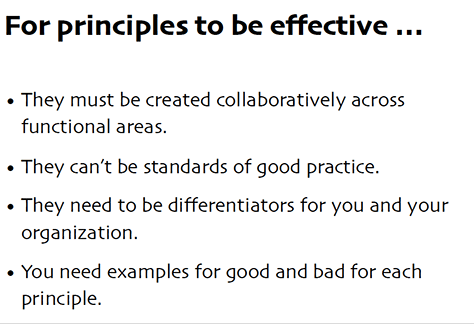
In Summary
In wrapping up, the teams broke upwards and nosotros discussed what would foreclose usa from using the knowledge we had gained from this workshop, what each participant would do to get past those obstacles, who each person could partner with to remove the obstacles, and what nosotros would exercise first when nosotros got back to work.
While I found Dave's workshop valuable, it was quite challenging to understand where nosotros were at any given point in the presentation. For example, by the time nosotros got to "Surveying the Mountain," I had a difficult time remembering what came first and what was adjacent. I felt a lack of orientation. In add-on, I constitute it difficult to understand why he had included certain topics inside a given segment of the workshop.
To analyze, the topics Dave shared were all valuable, and he included a peachy deal of information. Let'due south take "Surveying the Mount" as an instance once again. In this section, Dave talked about Mission, Vision, Purpose, and People—keeping things focused on human beings. We engaged in a break-out session during which nosotros created stories about how our blueprint teams communicate—the good and the bad. We and then created an affinity diagram, found commonalities, and worked to align our perspectives. My group and I very much enjoyed the practice. Still, it was difficult to understand how it fit into the concept of surveying the mountain inside the context of the course.
Perhaps the challenge I encountered arose considering Dave presented then much fabric and had to move and so fast. My recommendation to Dave would be to cover less detail and, instead, continue students focused on remembering his high-level bulletin. I walked abroad with and then many details Dave had presented in such rapid-burn succession that it was difficult for me to retrieve the nigh important points only a month later.
Allow me say once again that Dave's points were all valuable and securely insightful. The challenge was that in spite of his creating the great metaphor of climbing strategy mountain, I had a hard fourth dimension building a clear conceptual model of his bulletin. All in all, I would recommend this workshop, but I also recommend that Dave provide less detail and more context on where he is at any point in his climb upwardly the mount.
Conclusion
I'yard really glad I was able to attend EUX 2017. This is an excellent conference on an important topic for today's UX professionals and the concern customs in full general. I'm looking forward to attention EUX 2018, which will again take identify in San Francisco, on June 13–xv—kicking off with a full day of workshops, then the two days of the master conference, which hope to be packed with valuable content.![]()
Discount for UXmatters Readers—If you desire to attend EUX 2018, register using the discount code UXMATTERS and you'll get 15% off the toll of your briefing ticket.
Source: https://www.uxmatters.com/mt/archives/2018/03/conference-review-enterprise-ux-2017-part-1.php
0 Response to "Digital Thinkers Conference San Francisco Palace of the Fine Arts"
Post a Comment